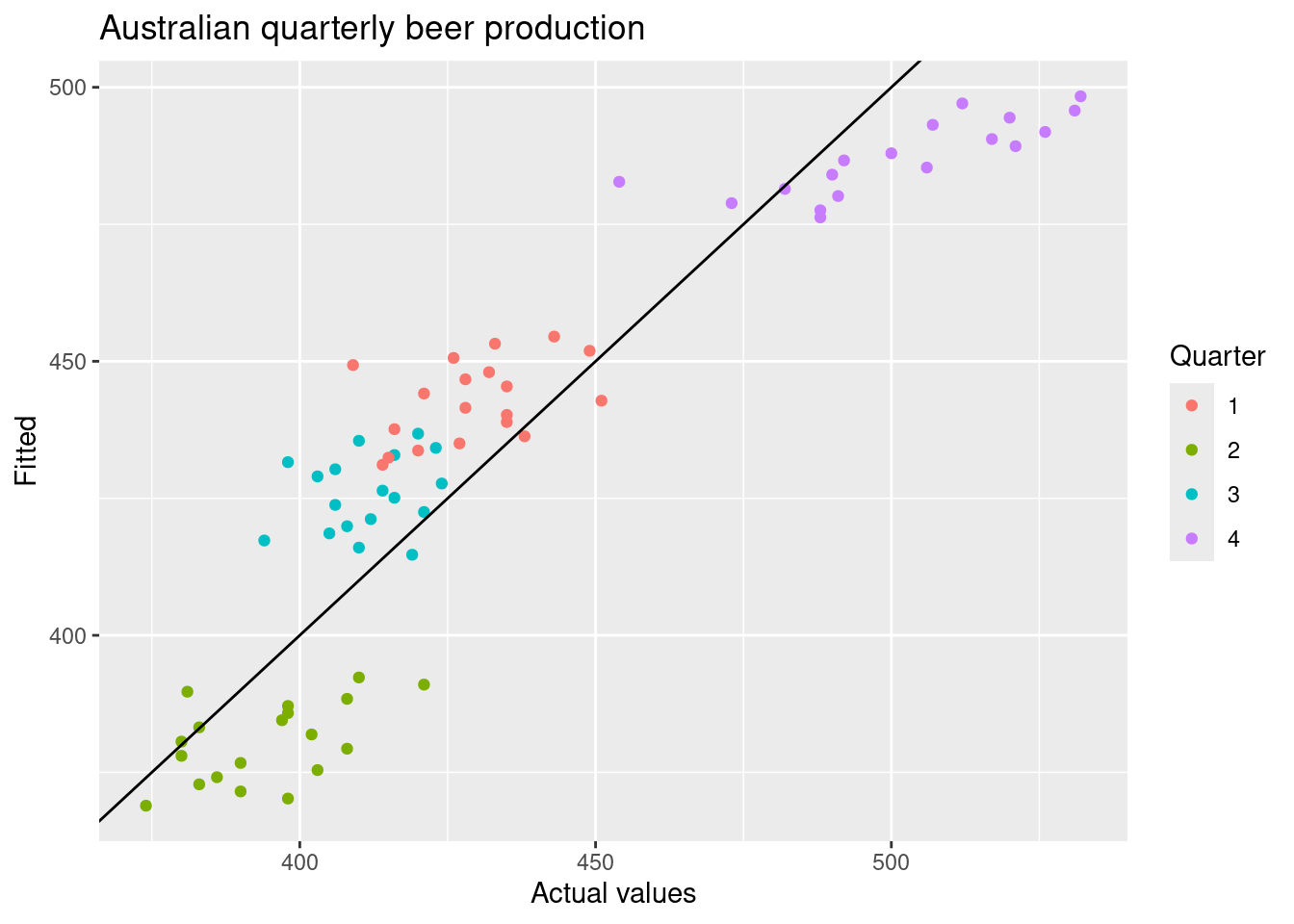7.4 Least squares estimation
“fitting” the model to the data, or sometimes “learning” or “training” the model.
“The least squares principle provides a way of choosing the coefficients effectively by minimizing the sum of the squared errors.” The Author
Formula: \(\sum_{t=1}^T{\epsilon_t^2}=\sum_{t=1}^T{(y_t-\beta_0+\beta_1x_{1,t}+\beta_2x_{2,t}+...+\beta_kx_{k,t}+\epsilon_t)^2}\)
\[\sum{\epsilon^2}=\sum{(Y-\beta X)^2}\]
fit_consMR <- us_change |>
model(tslm = TSLM(Consumption ~ Income + Production +
Unemployment + Savings))## # A tibble: 6 × 3
## Consumption .fitted .resid
## <dbl> <dbl> <dbl>
## 1 0.619 0.474 0.145
## 2 0.452 0.635 -0.183
## 3 0.873 0.931 -0.0583
## 4 -0.272 -0.212 -0.0603
## 5 1.90 1.64 0.264
## 6 0.915 1.07 -0.158augment(fit_consMR) |>
ggplot(aes(x = Consumption, y = .fitted)) +
geom_point(shape=21,stroke=0.5,fill="grey80") +
labs(
y = "Fitted (predicted values",
x = "Consumption observed values)",
title = "Percent change in US consumption expenditure"
) +
geom_abline(intercept = 0, slope = 1)
To summarise how well a linear regression model fits the data is via \(R^2\) the coefficient of determination.
The square of the correlation between the observed \(y\) values and the predicted \(\hat{y}\) values, ranges between 0 and 1.
\[R^2=\frac{\sum{(\hat{y_t}-\bar{y})^2}}{\sum{(y_t-\bar{y})^2}}\]
Residual standard error measure of how well the model has fitted the data.
\[\hat{\sigma}_e=\sqrt{\frac{1}{T-k-1}\sum_{t=1}^T{e_t^2}}\] \(k\) is the number of predictors
us_change |>
left_join(residuals(fit_consMR), by = "Quarter") |>
pivot_longer(Income:Unemployment,
names_to = "regressor", values_to = "x") |>
ggplot(aes(x = x, y = .resid)) +
geom_point() +
facet_wrap(. ~ regressor, scales = "free_x") +
labs(y = "Residuals", x = "")
augment(fit_consMR) |>
ggplot(aes(x = .fitted, y = .resid)) +
geom_point() + labs(x = "Fitted", y = "Residuals")
7.4.1 Example
recent_production <- aus_production |>
filter(year(Quarter) >= 1992)
fit_beer <- recent_production |>
model(TSLM(Beer ~ trend() + season()))augment(fit_beer) |>
ggplot(aes(x = Quarter)) +
geom_line(aes(y = Beer, colour = "Data")) +
geom_line(aes(y = .fitted, colour = "Fitted")) +
scale_colour_manual(
values = c(Data = "black", Fitted = "#D55E00")
) +
labs(y = "Megalitres",
title = "Australian quarterly beer production") +
guides(colour = guide_legend(title = "Series"))
augment(fit_beer) |>
ggplot(aes(x = Beer, y = .fitted,
colour = factor(quarter(Quarter)))) +
geom_point() +
labs(y = "Fitted", x = "Actual values",
title = "Australian quarterly beer production") +
geom_abline(intercept = 0, slope = 1) +
guides(colour = guide_legend(title = "Quarter"))
7.4.1.1 With transformation
fourier()The maximum allowed is \(K=m/2\) where \(m\) is the seasonal period.
augment(fourier_beer) |>
ggplot(aes(x = Quarter)) +
geom_line(aes(y = Beer, colour = "Data")) +
geom_line(aes(y = .fitted, colour = "Fitted")) +
scale_colour_manual(
values = c(Data = "black", Fitted = "#D55E00")
) +
labs(y = "Megalitres",
title = "Australian quarterly beer production") +
guides(colour = guide_legend(title = "Series"))
augment(fourier_beer) |>
ggplot(aes(x = Beer, y = .fitted,
colour = factor(quarter(Quarter)))) +
geom_point() +
labs(y = "Fitted", x = "Actual values",
title = "Australian quarterly beer production") +
geom_abline(intercept = 0, slope = 1) +
guides(colour = guide_legend(title = "Quarter"))